Lancia Musa 2010 Owner handbook (in English)
Manufacturer: LANCIA, Model Year: 2010, Model line: Musa, Model: Lancia Musa 2010Pages: 218, PDF Size: 3.71 MB
Page 161 of 218
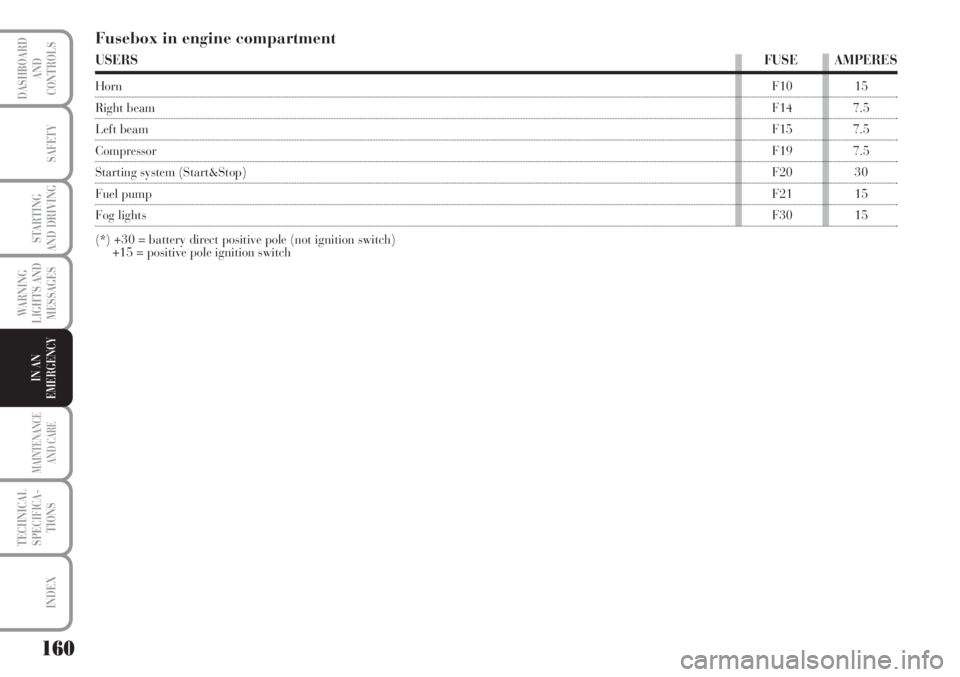
160
WARNING
LIGHTS AND
MESSAGES
MAINTENANCE
AND CARE
TECHNICAL
SPECIFICA-
TIONS
INDEX
DASHBOARD
AND
CONTROLS
SAFETY
STARTING
AND DRIVING
IN AN
EMERGENCY
Fusebox in engine compartment
USERSFUSE AMPERES
HornF10 15
Right beamF14 7.5
Left beamF15 7.5
CompressorF19 7.5
Starting system (Start&Stop)F20 30
Fuel pumpF21 15
Fog lightsF30 15
(*) +30 = battery direct positive pole (not ignition switch)
+15 = positive pole ignition switch
Page 162 of 218
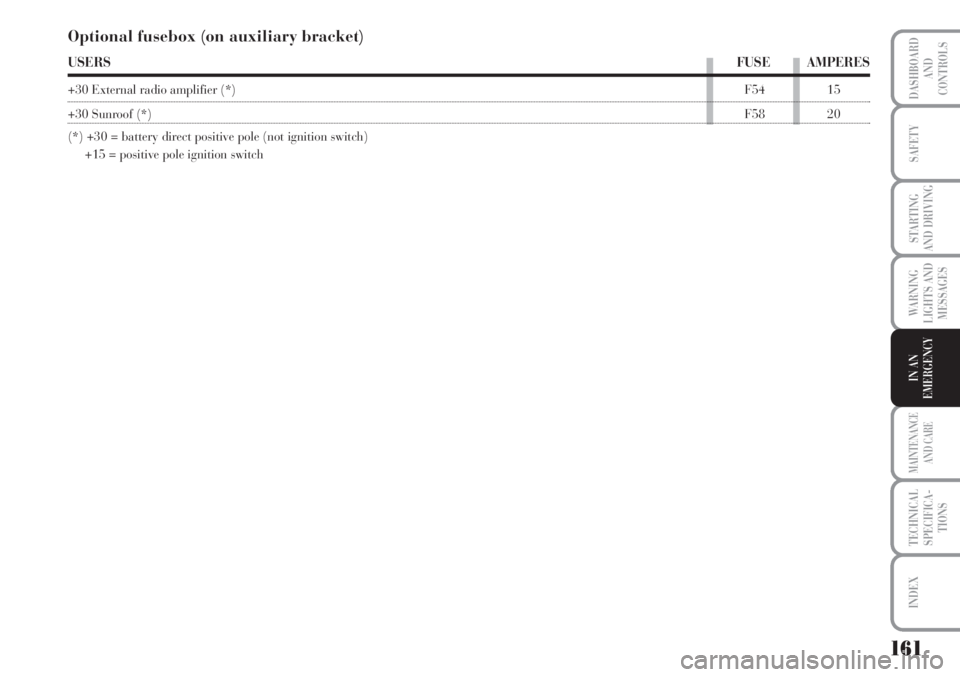
161
WARNING
LIGHTS AND
MESSAGES
MAINTENANCE
AND CARE
TECHNICAL
SPECIFICA-
TIONS
INDEX
DASHBOARD
AND
CONTROLS
SAFETY
STARTING
AND DRIVING
IN AN
EMERGENCY
Optional fusebox (on auxiliary bracket)
USERSFUSE AMPERES
+30 External radio amplifier (*)F54 15
+30 Sunroof (*)F58 20
(*) +30 = battery direct positive pole (not ignition switch)
+15 = positive pole ignition switch
Page 163 of 218
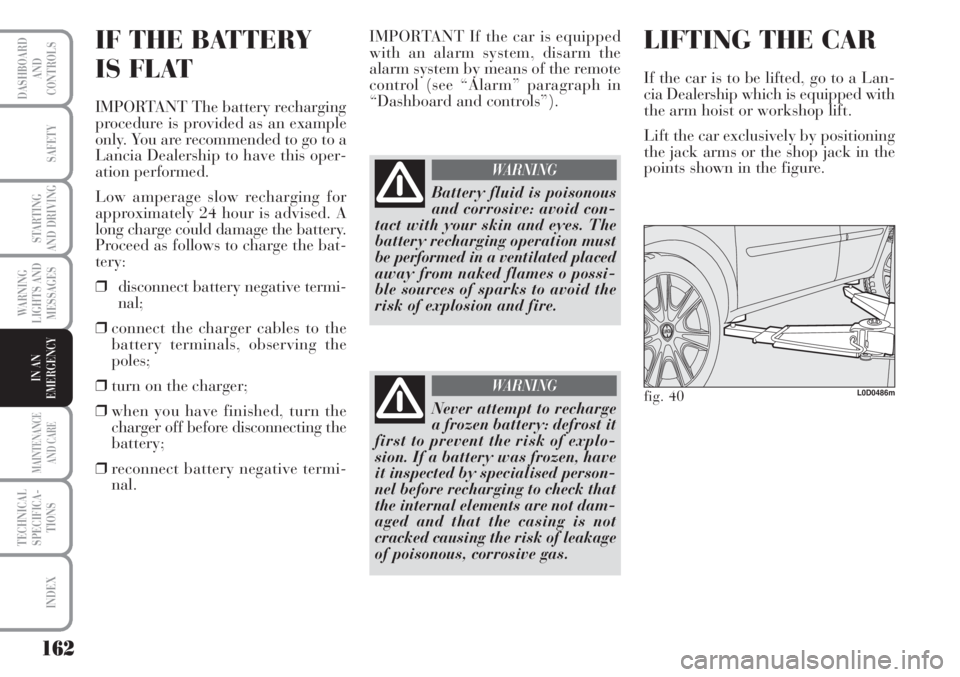
162
WARNING
LIGHTS AND
MESSAGES
MAINTENANCE
AND CARE
TECHNICAL
SPECIFICA-
TIONS
INDEX
DASHBOARD
AND
CONTROLS
SAFETY
STARTING
AND DRIVING
IN AN
EMERGENCY
IF THE BATTERY
IS FLAT
IMPORTANT The battery recharging
procedure is provided as an example
only. You are recommended to go to a
Lancia Dealership to have this oper-
ation performed.
Low amperage slow recharging for
approximately 24 hour is advised. A
long charge could damage the battery.
Proceed as follows to charge the bat-
tery:
❒disconnect battery negative termi-
nal;
❒connect the charger cables to the
battery terminals, observing the
poles;
❒turn on the charger;
❒when you have finished, turn the
charger off before disconnecting the
battery;
❒reconnect battery negative termi-
nal.IMPORTANT If the car is equipped
with an alarm system, disarm the
alarm system by means of the remote
control (see “Alarm” paragraph in
“Dashboard and controls”).
LIFTING THE CAR
If the car is to be lifted, go to a Lan-
cia Dealership which is equipped with
the arm hoist or workshop lift.
Lift the car exclusively by positioning
the jack arms or the shop jack in the
points shown in the figure.
Battery fluid is poisonous
and corrosive: avoid con-
tact with your skin and eyes. The
battery recharging operation must
be performed in a ventilated placed
away from naked flames o possi-
ble sources of sparks to avoid the
risk of explosion and fire.
WARNING
Never attempt to recharge
a frozen battery: defrost it
first to prevent the risk of explo-
sion. If a battery was frozen, have
it inspected by specialised person-
nel before recharging to check that
the internal elements are not dam-
aged and that the casing is not
cracked causing the risk of leakage
of poisonous, corrosive gas.
WARNINGfig. 40L0D0486m
Page 164 of 218
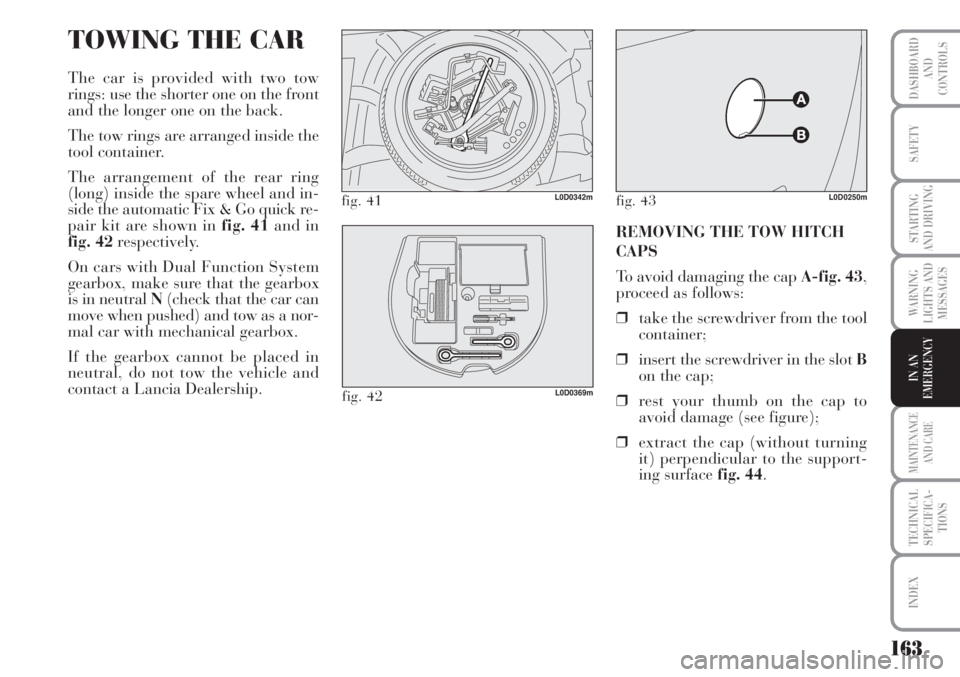
163
WARNING
LIGHTS AND
MESSAGES
MAINTENANCE
AND CARE
TECHNICAL
SPECIFICA-
TIONS
INDEX
DASHBOARD
AND
CONTROLS
SAFETY
STARTING
AND DRIVING
IN AN
EMERGENCY
TOWING THE CAR
The car is provided with two tow
rings: use the shorter one on the front
and the longer one on the back.
The tow rings are arranged inside the
tool container.
The arrangement of the rear ring
(long) inside the spare wheel and in-
side the automatic Fix & Go quick re-
pair kit are shown in fig. 41 and in
fig. 42 respectively.
On cars with Dual Function System
gearbox, make sure that the gearbox
is in neutral N(check that the car can
move when pushed) and tow as a nor-
mal car with mechanical gearbox.
If the gearbox cannot be placed in
neutral, do not tow the vehicle and
contact a Lancia Dealership.
fig. 41L0D0342m
fig. 42L0D0369m
REMOVING THE TOW HITCH
CAPS
To avoid damaging the cap A-fig. 43,
proceed as follows:
❒take the screwdriver from the tool
container;
❒insert the screwdriver in the slot B
on the cap;
❒rest your thumb on the cap to
avoid damage (see figure);
❒extract the cap (without turning
it) perpendicular to the support-
ing surface fig. 44.
fig. 43L0D0250m
Page 165 of 218
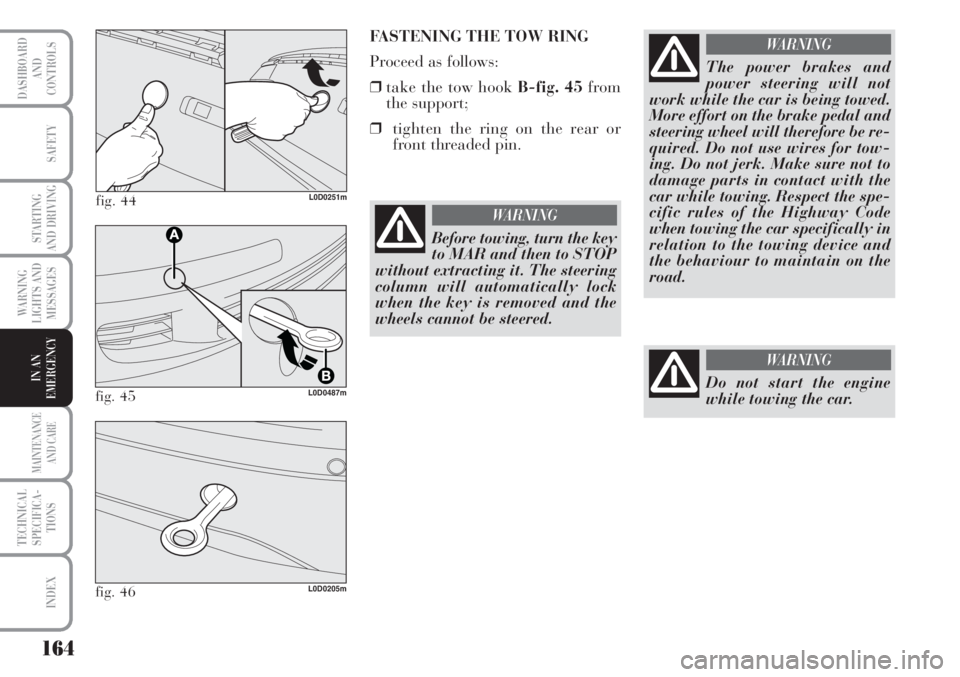
164
WARNING
LIGHTS AND
MESSAGES
MAINTENANCE
AND CARE
TECHNICAL
SPECIFICA-
TIONS
INDEX
DASHBOARD
AND
CONTROLS
SAFETY
STARTING
AND DRIVING
IN AN
EMERGENCY
fig. 44L0D0251m
FASTENING THE TOW RING
Proceed as follows:
❒take the tow hook B-fig. 45from
the support;
❒tighten the ring on the rear or
front threaded pin.
fig. 45L0D0487m
fig. 46L0D0205m
The power brakes and
power steering will not
work while the car is being towed.
More effort on the brake pedal and
steering wheel will therefore be re-
quired. Do not use wires for tow-
ing. Do not jerk. Make sure not to
damage parts in contact with the
car while towing. Respect the spe-
cific rules of the Highway Code
when towing the car specifically in
relation to the towing device and
the behaviour to maintain on the
road.
WARNING
Before towing, turn the key
to MAR and then to STOP
without extracting it. The steering
column will automatically lock
when the key is removed and the
wheels cannot be steered.
WARNING
Do not start the engine
while towing the car.
WARNING
Page 166 of 218
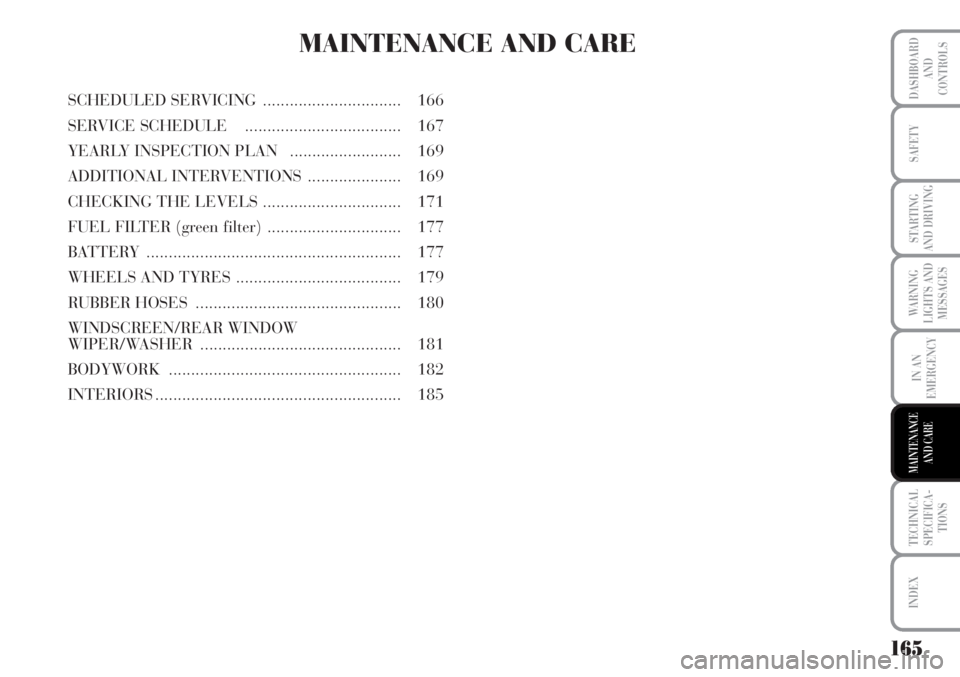
165
WARNING
LIGHTS AND
MESSAGES
TECHNICAL
SPECIFICA-
TIONS
INDEX
DASHBOARD
AND
CONTROLS
SAFETY
STARTING
AND DRIVING
IN AN
EMERGENCY
MAINTENANCE
AND CARE
MAINTENANCE AND CARE
SCHEDULED SERVICING............................... 166
SERVICE SCHEDULE................................... 167
YEARLY INSPECTION PLAN ......................... 169
ADDITIONAL INTERVENTIONS ..................... 169
CHECKING THE LEVELS............................... 171
FUEL FILTER (green filter).............................. 177
BATTERY ......................................................... 177
WHEELS AND TYRES ..................................... 179
RUBBER HOSES .............................................. 180
WINDSCREEN/REAR WINDOW
WIPER/WASHER ............................................. 181
BODYWORK.................................................... 182
INTERIORS....................................................... 185
Page 167 of 218
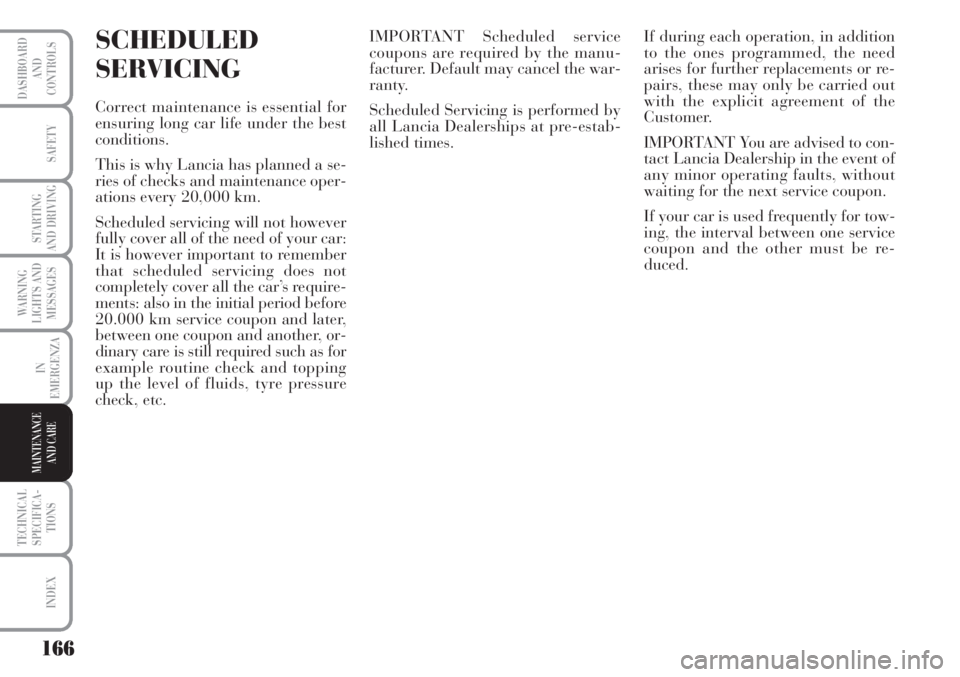
166
WARNING
LIGHTS AND
MESSAGES
TECHNICAL
SPECIFICA-
TIONS
INDEX
DASHBOARD
AND
CONTROLS
SAFETY
STARTING
AND DRIVING
IN
EMERGENZA
MAINTENANCE
AND CARE
SCHEDULED
SERVICING
Correct maintenance is essential for
ensuring long car life under the best
conditions.
This is why Lancia has planned a se-
ries of checks and maintenance oper-
ations every 20,000 km.
Scheduled servicing will not however
fully cover all of the need of your car:
It is however important to remember
that scheduled servicing does not
completely cover all the car’s require-
ments: also in the initial period before
20.000 km service coupon and later,
between one coupon and another, or-
dinary care is still required such as for
example routine check and topping
up the level of fluids, tyre pressure
check, etc.IMPORTANT Scheduled service
coupons are required by the manu-
facturer. Default may cancel the war-
ranty.
Scheduled Servicing is performed by
all Lancia Dealerships at pre-estab-
lished times.If during each operation, in addition
to the ones programmed, the need
arises for further replacements or re-
pairs, these may only be carried out
with the explicit agreement of the
Customer.
IMPORTANT You are advised to con-
tact Lancia Dealership in the event of
any minor operating faults, without
waiting for the next service coupon.
If your car is used frequently for tow-
ing, the interval between one service
coupon and the other must be re-
duced.
Page 168 of 218
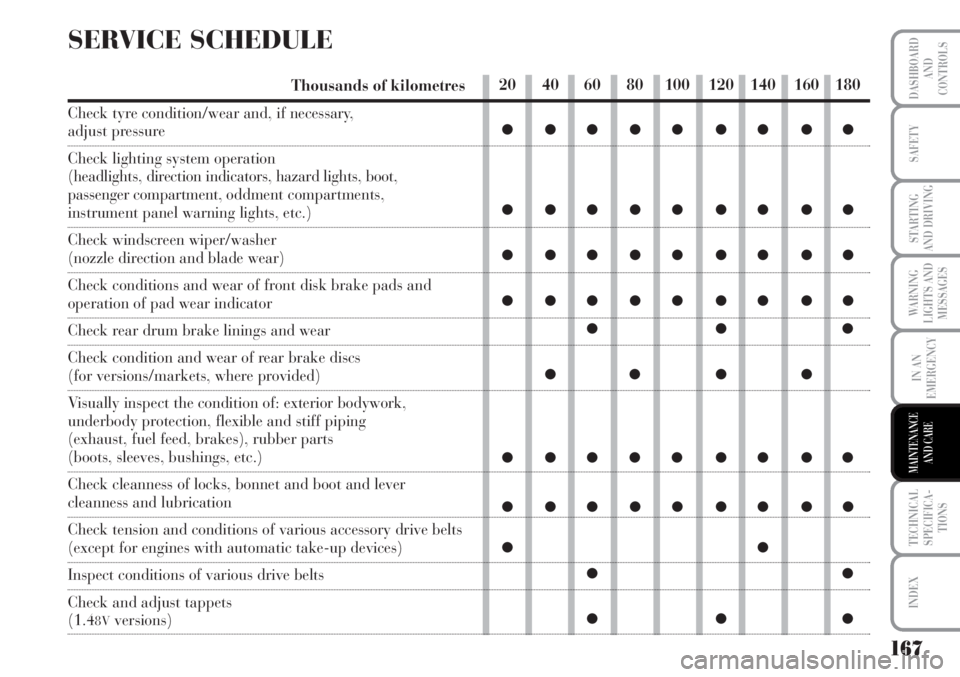
167
WARNING
LIGHTS AND
MESSAGES
TECHNICAL
SPECIFICA-
TIONS
INDEX
DASHBOARD
AND
CONTROLS
SAFETY
STARTING
AND DRIVING
IN AN
EMERGENCY
MAINTENANCE
AND CARE
SERVICE SCHEDULE
Thousands of kilometres
Check tyre condition/wear and, if necessary,
adjust pressure
Check lighting system operation
(headlights, direction indicators, hazard lights, boot,
passenger compartment, oddment compartments,
instrument panel warning lights, etc.)
Check windscreen wiper/washer
(nozzle direction and blade wear)
Check conditions and wear of front disk brake pads and
operation of pad wear indicator
Check rear drum brake linings and wear
Check condition and wear of rear brake discs
(for versions/markets, where provided)
Visually inspect the condition of: exterior bodywork,
underbody protection, flexible and stiff piping
(exhaust, fuel feed, brakes), rubber parts
(boots, sleeves, bushings, etc.)
Check cleanness of locks, bonnet and boot and lever
cleanness and lubrication
Check tension and conditions of various accessory drive belts
(except for engines with automatic take-up devices)
Inspect conditions of various drive belts
Check and adjust tappets
(1.48Vversions)
20 40 60 80 100 120 140 160 180
●●●●● ●●●●
●●●●● ●●●●
●●●●● ●●●●
●●●●● ●●●●
●●●
●● ● ●
●●●●● ●●●●
●●●●● ●●●●
●●
●●
●●●
Page 169 of 218
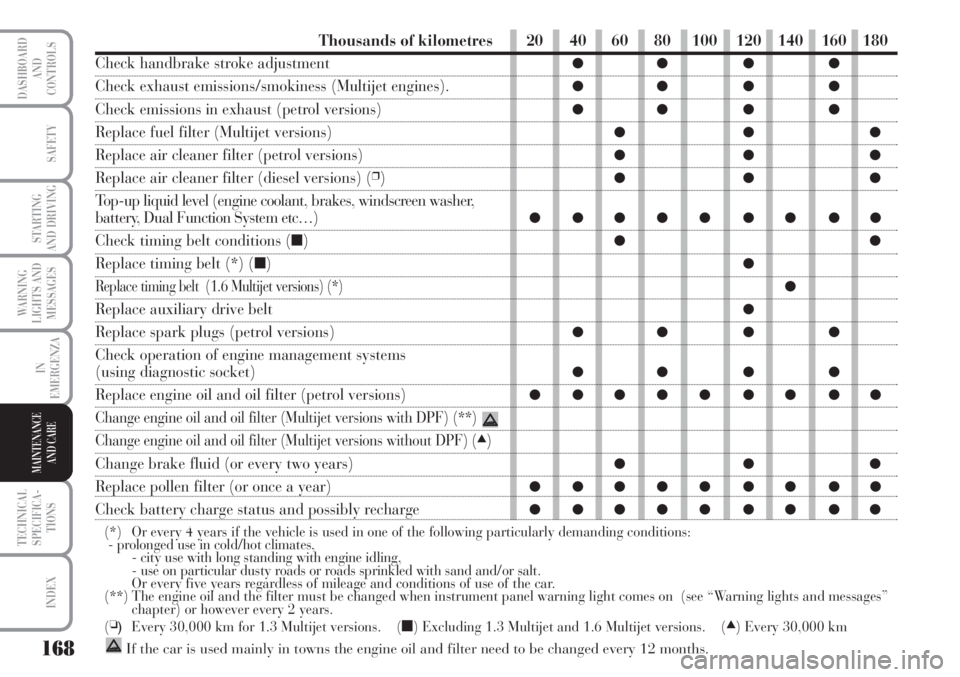
168
WARNING
LIGHTS AND
MESSAGES
TECHNICAL
SPECIFICA-
TIONS
INDEX
DASHBOARD
AND
CONTROLS
SAFETY
STARTING
AND DRIVING
IN
EMERGENZA
MAINTENANCE
AND CARE
Thousands of kilometres
Check handbrake stroke adjustment
Check exhaust emissions/smokiness (Multijet engines).
Check emissions in exhaust (petrol versions)
Replace fuel filter (Multijet versions)
Replace air cleaner filter (petrol versions)
Replace air cleaner filter (diesel versions) (❒)
Top-up liquid level (engine coolant, brakes, windscreen washer,
battery, Dual Function System etc…)
Check timing belt conditions (■)
Replace timing belt (*) (■)
Replace timing belt (1.6 Multijet versions) (*)
Replace auxiliary drive belt
Replace spark plugs (petrol versions)
Check operation of engine management systems
(using diagnostic socket)
Replace engine oil and oil filter (petrol versions)
Change engine oil and oil filter (Multijet versions with DPF) (**)
Change engine oil and oil filter (Multijet versions without DPF) (▲)
Change brake fluid (or every two years)
Replace pollen filter (or once a year)
Check battery charge status and possibly recharge
(*) Or every 4 years if the vehicle is used in one of the following particularly demanding conditions:
- prolonged use in cold/hot climates,
- city use with long standing with engine idling,
- use on particular dusty roads or roads sprinkled with sand and/or salt.
Or every five years regardless of mileage and conditions of use of the car.
(**) The engine oil and the filter must be changed when instrument panel warning light comes on (see “Warning lights and messages”
chapter) or however every 2 years.
(
❏)Every 30,000 km for 1.3 Multijet versions. (■) Excluding 1.3 Multijet and 1.6 Multijet versions. (▲) Every 30,000 km
If the car is used mainly in towns the engine oil and filter need to be changed every 12 months.
20 40 60 80 100 120 140 160 180
●● ● ●
●● ● ●
●● ● ●
●●●
●●●
●●●
●●●●● ●●●●
●●
●
●
●
●● ● ●
●● ● ●
●●●●● ●●●●
●●●
●●●●● ●●●●
●●●●● ●●●●
Page 170 of 218
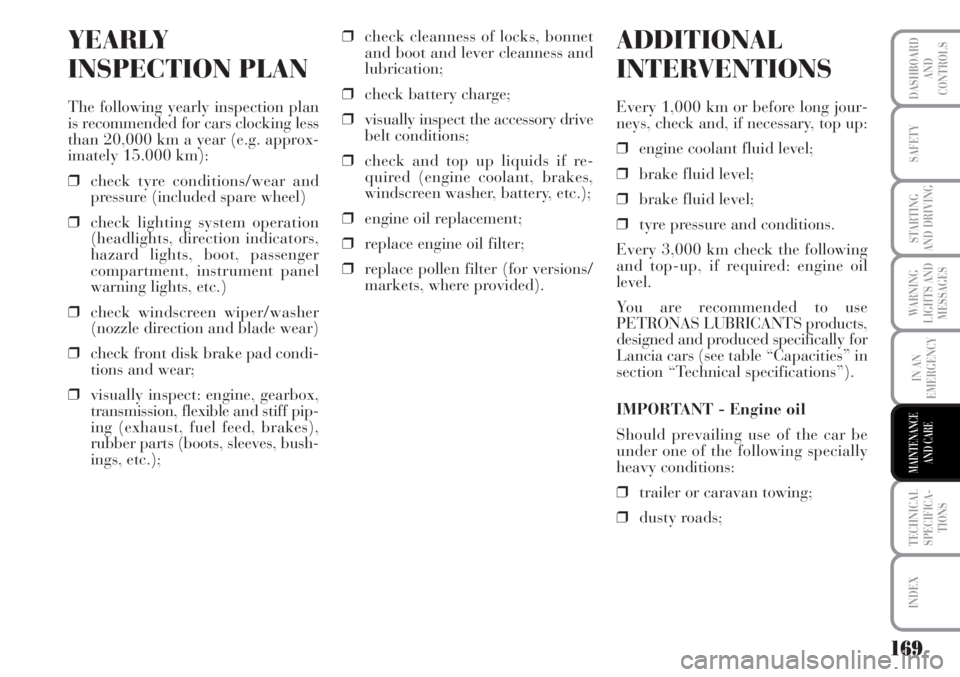
169
WARNING
LIGHTS AND
MESSAGES
TECHNICAL
SPECIFICA-
TIONS
INDEX
DASHBOARD
AND
CONTROLS
SAFETY
STARTING
AND DRIVING
IN AN
EMERGENCY
MAINTENANCE
AND CARE
YEARLY
INSPECTION PLAN
The following yearly inspection plan
is recommended for cars clocking less
than 20,000 km a year (e.g. approx-
imately 15.000 km):
❒check tyre conditions/wear and
pressure (included spare wheel)
❒check lighting system operation
(headlights, direction indicators,
hazard lights, boot, passenger
compartment, instrument panel
warning lights, etc.)
❒check windscreen wiper/washer
(nozzle direction and blade wear)
❒check front disk brake pad condi-
tions and wear;
❒visually inspect: engine, gearbox,
transmission, flexible and stiff pip-
ing (exhaust, fuel feed, brakes),
rubber parts (boots, sleeves, bush-
ings, etc.);❒check cleanness of locks, bonnet
and boot and lever cleanness and
lubrication;
❒check battery charge;
❒visually inspect the accessory drive
belt conditions;
❒check and top up liquids if re-
quired (engine coolant, brakes,
windscreen washer, battery, etc.);
❒engine oil replacement;
❒replace engine oil filter;
❒replace pollen filter (for versions/
markets, where provided).
ADDITIONAL
INTERVENTIONS
Every 1,000 km or before long jour-
neys, check and, if necessary, top up:
❒engine coolant fluid level;
❒brake fluid level;
❒brake fluid level;
❒tyre pressure and conditions.
Every 3,000 km check the following
and top-up, if required: engine oil
level.
You are recommended to use
PETRONAS LUBRICANTS products,
designed and produced specifically for
Lancia cars (see table “Capacities” in
section “Technical specifications”).
IMPORTANT - Engine oil
Should prevailing use of the car be
under one of the following specially
heavy conditions:
❒trailer or caravan towing;
❒dusty roads;